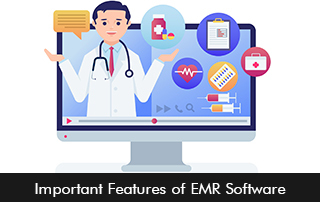The complex world of healthcare solutions require Electronic Medical Records (EMR) Software for increasing efficiency and defining patient treatment plans. In addition to reducing a large number of routine processes to enable advanced features empowering healthcare providers, EHR Software brings improvement to health militating.
Critical EMR Software Tools
Intuitive EHR Software Patient Charting
EMR Software provides charts that categorize the patient’s records in a format that allows providers to easily review the patient’s medical history at the click of a button. This enhances decision-making and care precision, as the clinician has all the data, including diagnosis, prescriptions, and treatment details, in their database.
Appointment Scheduling Functionality
Whereas the options that are self-scheduled by patients minimize time and overhead, Electronic Health Records (EHR) Software automates and streamlines scheduling. This feature reduces the possibility of making wrong appointments, increases patient satisfaction and assists providers in better management of their time table. It also includes auto-reminders that prevent patient cancellation of appointments and keep patients on schedule. Alleviating the grave issue of appointment no-shows. Alleviating the grave issue of appointment no-shows. The national average no-show rate is roughly 18%.
E-prescribing Tools and Medication Management
The e-prescribing tools enhance the quality of prescriptions by providing a feature that allows the care provider to prescribe electronically the medications to the pharmacy. This particular functionality reduces the prospect of medical mistakes, as well as the amount of time that practitioners and patients must dedicate to this task. Some EMR systems also present features that inform the healthcare provider about possible medication interactions to preventing harm that may be caused by interaction before the final prescription is made.
Data Analytics and Reporting
EHR Software provides data analytics and reporting features in which providers can use patient data and look for patterns to create a concept on where modifications need to be made. These insights assist in decision making so as to take early necessary interventions in care plans, while also helping improve population and public health.
Improved Financial Health with RCM Software Tools in EMR Software
It can be a cumbersome task for healthcare providers to manage tedious and complex medical billing along with patient care. The technology of Electronic Medical Records software integrates sophisticated billing and revenue cycle management features to optimize financial processes.
RCM solutions help to reduce billing errors, improve financial accuracy, and enable practices to get paid faster. Patients also appreciate the financial transparency and any payment issues are resolved without any delays.
Patient Engagement with EMR Software
The patient portal functionality in EHR Software lets patients and their families gain access to personal health information, test results, appointments, and possibility of the secure messaging with doctors.
It empowers patients to solve their health issues independently and also frees up physicians’ time as fewer people will need physical consultations for appointments. Patients who are highly engaged tend to be more satisfied and adhere better to their medication schedules and the necessary protocols suggested by their doctor.







